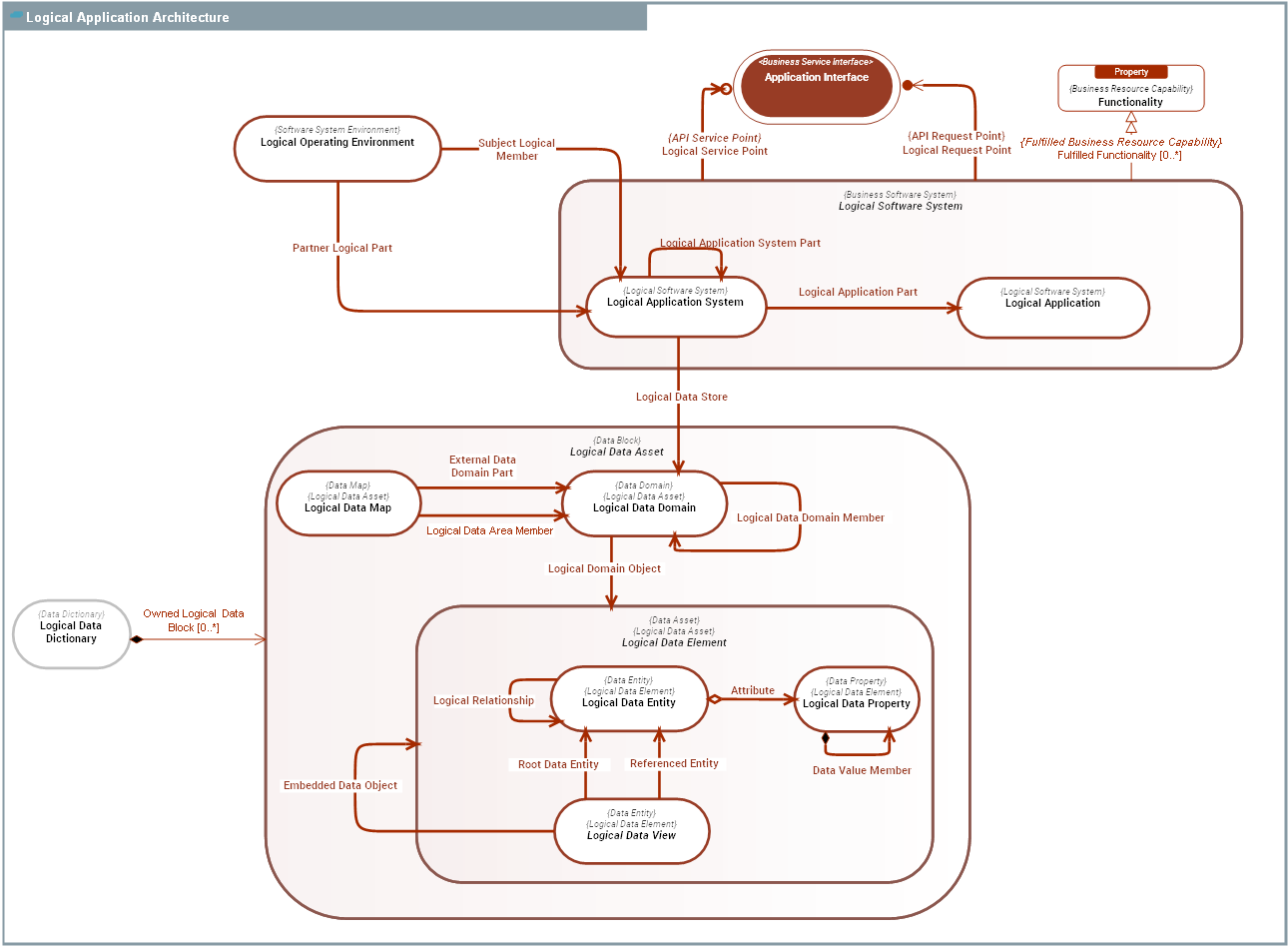CONCEPT DOMAIN - Logical Application Architecture
| Description | The Logical Application Architecture domain provides means of describing the logical structure and behavior of Business Software Systems of the enterprise. The aim of Logical Application Architecture is to describe an optimal optimal architecture of the enterprise IT systems. It is used to guide how key sub-systems and data domains are to be configured to meet IT systems missions and purposes. A Logical Application Architecture is concerned with how the IT Operating Model should look, not how it does look now. This includes: 1) Logical Application as the core building logical blocks for software components. 2) Logical Application System as consistent ssembly of Logical Applications. 3) Logical Data Domains of data entities. 4) Functionality(ies) fulfilled by logical systems. 5) Functional APIs exposed and used by applications: Application Interfaces. |
|---|---|
| Dictionary |  Dictionary of SysFEAT concepts
Dictionary of SysFEAT concepts |
| Parent Domain |  Software System ArcOps
Software System ArcOps |
| Domain dependencies |  EA Pattern - Business Software System Pattern
EA Pattern - Business Software System Pattern  EA Pattern - Data Domain
EA Pattern - Data Domain |
DOMAIN CONCEPT GRAPH
Diagram Graph

CONCEPT DESCRIPTIONS
Concrete Concepts
| Concept | Description |
|---|---|
 Application Interface
Application Interface |
An Application Interface is a Business Service Interface that occurs between Business Software Systems. The interface is described by messages exchanged between endpoints (provider, consumer..). |
 Functionality
Functionality |
A Functionality is a Business Resource Capability offered by Business System Assets (software or hardware) and aimed at delivering Information Outcomes. A Functionality describes WHAT a software or hardware system can provide. Functionality(ies) are used to express the Business System features required by people when performing their job (see Job-to-be-done). For internal customers, these jobs correspond to Business-Process Steps described in Business Process (see Instrument) For enterprise Customers, these jobs correspond to Job-to-be-done in the context of Customer Journeys. |
 Logical Application
Logical Application |
A Logical Application is an encapsulation of application functionality that is independent of a particular implementation. For example, the classification of all purchase request processing applications implemented in an enterprise. |
 Logical Application System
Logical Application System |
A Logical Application Architecture is an assembly of other Logical Application Architectures, of Logical Applications and of end users, in order to realize one of more functionalities. |
 Logical Data Dictionary
Logical Data Dictionary |
Dictionary of Logical Data Entity. |
 Logical Data Domain
Logical Data Domain |
A Logical Data Domain is used to define a logical data structure made up of Logical Data Entity(ies) and data views. |
 Logical Data Entity
Logical Data Entity |
A Logical Data Entity is a logical structure of a Data Entity. As any Data Entity, it has an independent existence and can be uniquely identified. A Logical Data Entity is characterized by Logical Relationships it has with other Logical Data Entity(ies) and by its Attributes. |
 Logical Data Map
Logical Data Map |
|
 Logical Data Property
Logical Data Property |
A Logical Data Property is an immutable type that is distinguishable only by the state of its properties. That is, unlike a Logical Data Entity, which has a unique identifier and remains distinct even if its properties are otherwise identical, two Value Objects with the exact same properties can be considered equal. |
 Logical Operating Environment
Logical Operating Environment |
A Logical Operating Environment presents a logical application system use context. It describes the interactions between the Logical Application System and its external partners, which allows it to fulfill its mission and ensure the expected functionalities. |
Abstract Concepts
| Concept | Description |
|---|---|
 Logical Data Asset
Logical Data Asset |
A Logical Data Asset is a Data Asset used for the description of data consumed and produced by Logical Software Systems. Logical Data Assets are defined in Logical Data Dictionary(ies). |
 Logical Data Element
Logical Data Element |
A Logical Data Element represents the logical structure of any kind of data that can be memorized by a Business Software System. A Logical Data Element is either a Logical Data Entity or a Logical Data Property. Only Logical Data Entitys can have identity and can be referenced by Logical Relationships. Logical Data Propertys only handle raw data. |
 Logical Data View
Logical Data View |
A Logical Data View a collection of filtered Logical Data Entitys. |
 Logical Software System
Logical Software System |
A Logical Software System is logical specification of a Business Software System, which is independant from the Business Software System physical implementation. For instance, "Human Resource ERP System" is a Logical Application System, while "SAP HR System", "Sage HR System", "Kronos HR System" are Application Systems. |
 EIP - messaging
EIP - messaging Martin Fowler - API Design
Martin Fowler - API Design